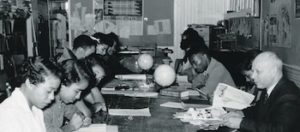
*Passover begins on this date in 2025, and on this holiday in 1933, we affirm the beginning of white-European Jewish academic relationships with Blacks on HBCU campuses in America.
Only months after Hitler seized power in Germany in the spring of 1933, Jewish intellectuals who had held prestigious positions in Germany's renowned universities were targeted for expulsion. One of the first pieces of Nazi legislation excluded “non-Aryans” from civil service or academic positions in Germany. Those who dared to oppose the decree were met with brutal suppression.
Many of these scholars fled to America, often leaving with little more than the clothes on their backs, hoping to continue their academic careers. They soon found themselves in a strange and mysterious country, a nation reeling from the Depression and filled with anti-Semitic and anti-German sentiment. They discovered a new form of persecution in the Jim Crow South, where they taught at historically black Colleges and Universities (HBCUs).
While the most famous refugees, like Albert Einstein, were welcomed into the hallowed halls of Eastern academia, most of these other scholars faced an aloof academic world, if not downright hostile. Much to their surprise, many were welcomed into a group of colleges where most white American professors ignored the historically all-Black colleges in the South.
For the Black colleges, including Howard University, Hampton Institute, and Tougaloo and Talladega Colleges, these refugee professors provided the opportunity to add great talent to their faculty; for the professors, the arrangement provided a new home, a classroom of students eager to learn, and an insider's look at an America that few had ever seen. While most of these pairings between Jewish refugees and Black colleges began as marriages of convenience, they often blossomed into matches that lasted a lifetime. Dr. Ismar Schorsch, Chancellor of the Jewish Theological Seminary, stated, "They found a place where they could contribute, and they found a place where they could pursue their intellectual life. They found a place where they could make a difference."
They were the cream of German society, some of the most brilliant scholars of Europe,” says Emily Zimmern, president of the Levine. “They went to poorly funded black colleges, but what they discovered were incredible students.” Some leading scholars were thrown out of work, including University of Hamburg law professor Albrecht Mendelssohn Bartholdy, grandson of the famous composer. Many tried to emigrate to the United States during the Great Depression. Feelings were strong against foreigners taking work that could go to unemployed Americans. “It was a xenophobic time of economic distress,” Zimmern says. “People were worried about jobs.” Jewish philanthropists underwrote the salaries of some well-established scholars at top universities. Those with lesser reputations found work as butlers or cooks. About 50 found work at Southern Black Colleges.
One was the noted Greek philosophy expert Ernst Moritz Manasse, who found a teaching position at the North Carolina College for Negroes (now North Carolina Central University) in Durham. Among his students was Julius Chambers, who became a prominent Charlotte civil rights attorney. Wade Kornegay, son of a tenant farmer from Mount Olive, was another of his students. Kornegay won a Fulbright scholarship and later became a leading expert on ballistic missile defense at MIT. Manasse was not prepared for the rigid segregation in the South that his students faced; he later said, “I came from a situation of forced segregation where we were victims, and now I belonged not to the oppressed, but to the oppressor. And that was very, very uncomfortable for me”.
Jeffrey Leak, director of the Center for the Study of the New South at UNC Charlotte, says the connection between Blacks and Jews has a far more complex history than most people know. In the civil rights era, for example, Jews were involved behind the scenes in activist groups like the NAACP and Urban League. “For blacks that don’t want to hear or believe that we have a history tied to Jews and Jews who might want to believe the reverse, the history is full of contradictions,” Leak says. “Like it or not, we’re all family in a way, especially in the South,” Zimmern said, saying that the cultural dynamic between the Jewish professors and the black students proved transformational for both.
In the 1940s, John Biggers of Gastonia, N.C., had been studying to become a plumber when refugee professor Viktor Lowenfeld mentored him. They met at Hampton Institute in Virginia. Lowenfeld ignited a love of art in Biggers, known for his narrative murals and for founding the art department at Texas Southern University. “Viktor took us to the African museum and taught us the meaning of African art,” Biggers later wrote. “He was also interested in our inner feelings, what made us tick. We express the most meaningful things in art.”
Lore May Rasmussen, teaching at Talladega University, was fined $28 in 1942 for sitting with a Black acquaintance at a Birmingham, Ala. The cafe violates city code requiring patrons to be separated by race. “As soon as we left the Talladega campus, we found a situation of extreme apartheid that appeared as insanity to us,” she later said. “We were in what we might call the best of America and the worst of America.” Rasmussen’s children worked at a black-owned co-operative store. She recalled: “Some of the local people asked, ‘Are these white boys?’ and somebody said, ‘No, these are Jew boys.’ And then, ‘What are Jews?’ “Well, they are some sort of colored folks.’ ” These Jewish scholars and their little-known stories are told in a traveling exhibit, “Beyond Swastika and Jim Crow: Jewish Refugee Scholars at Black Colleges.”